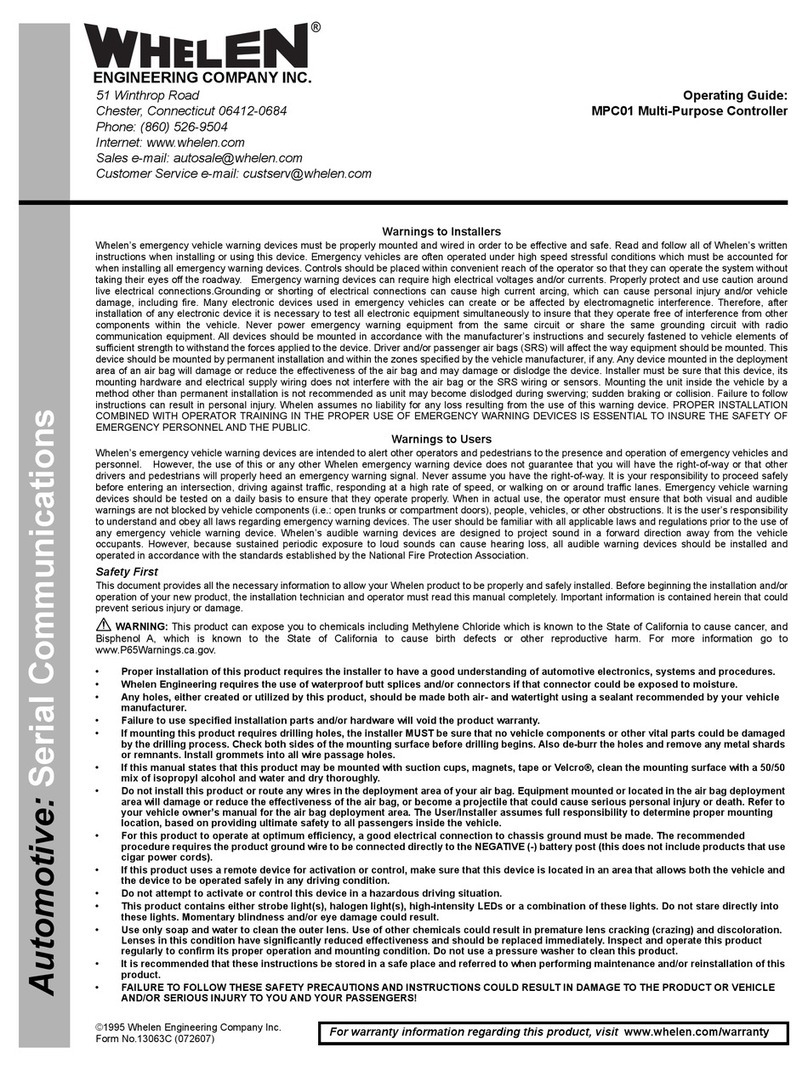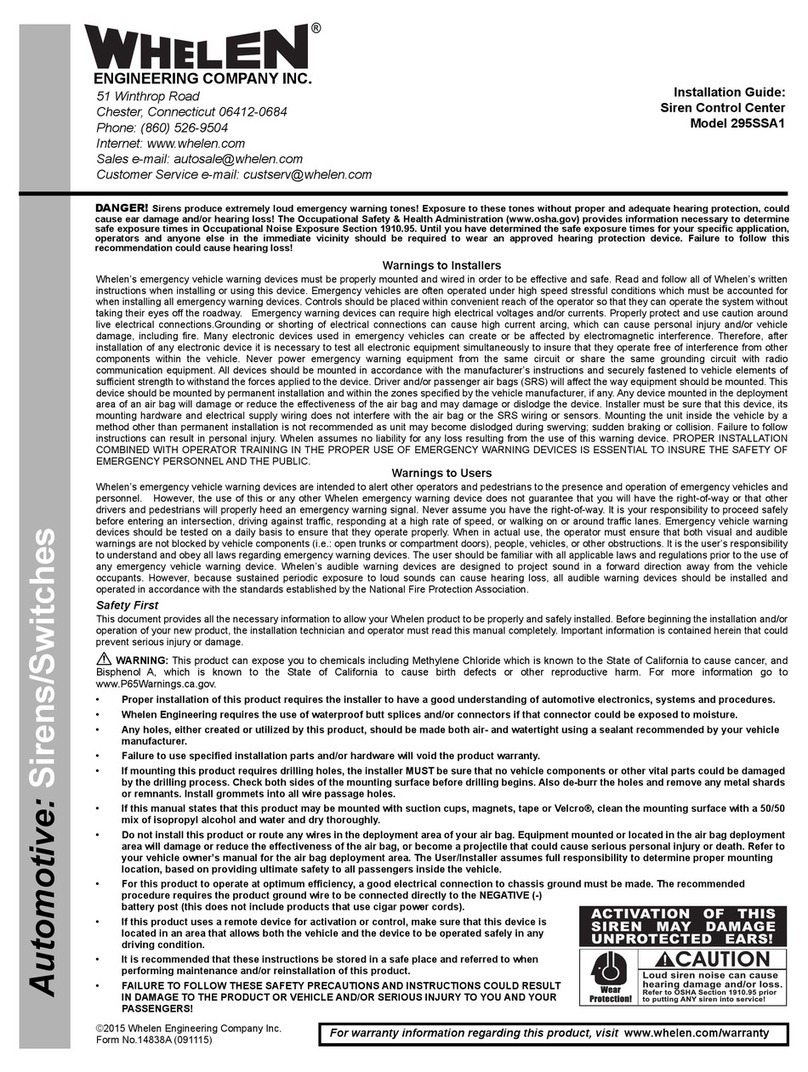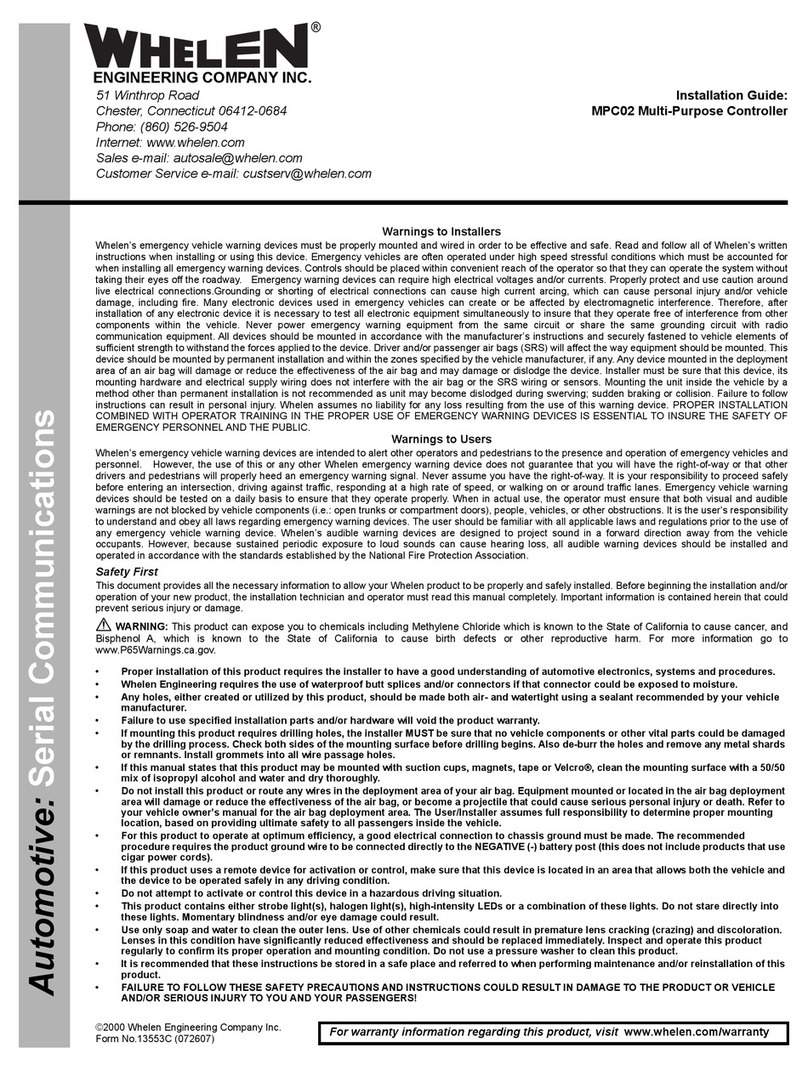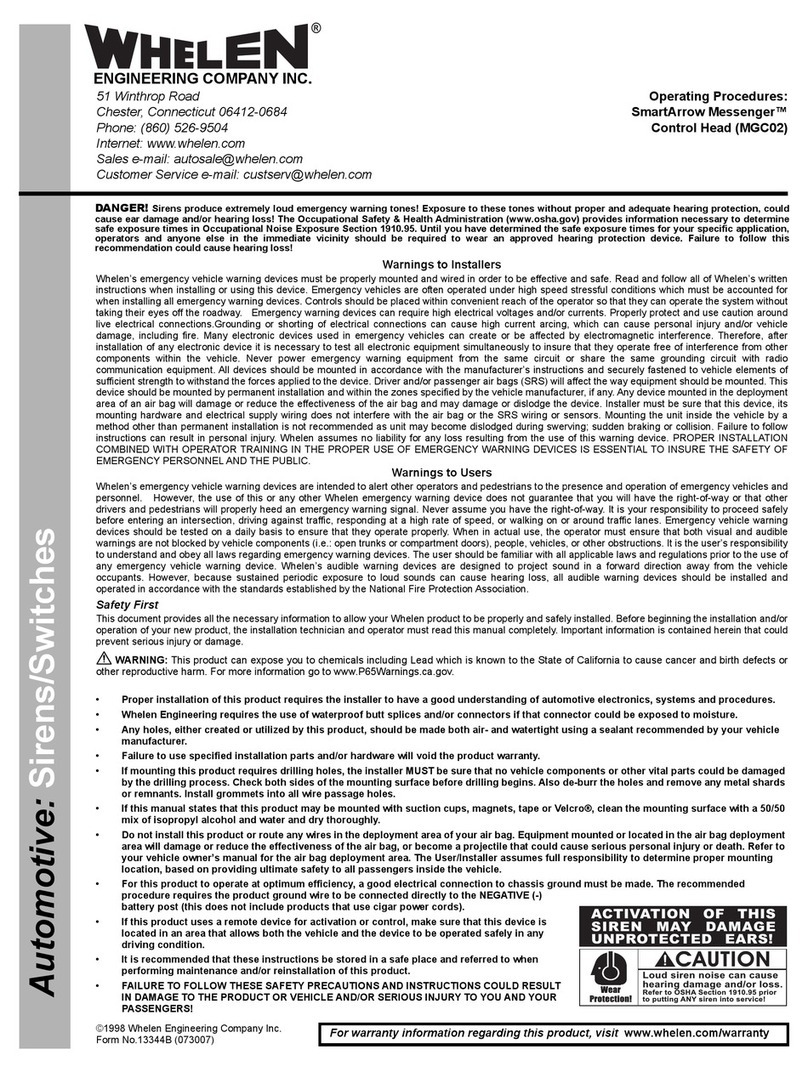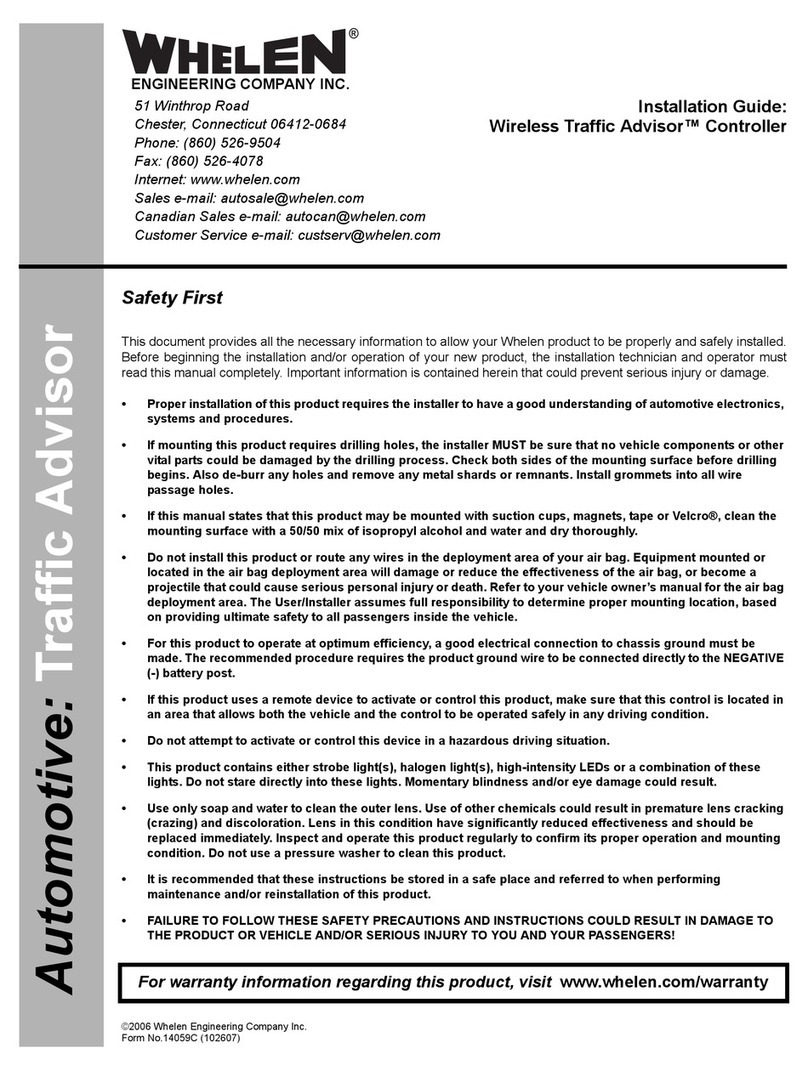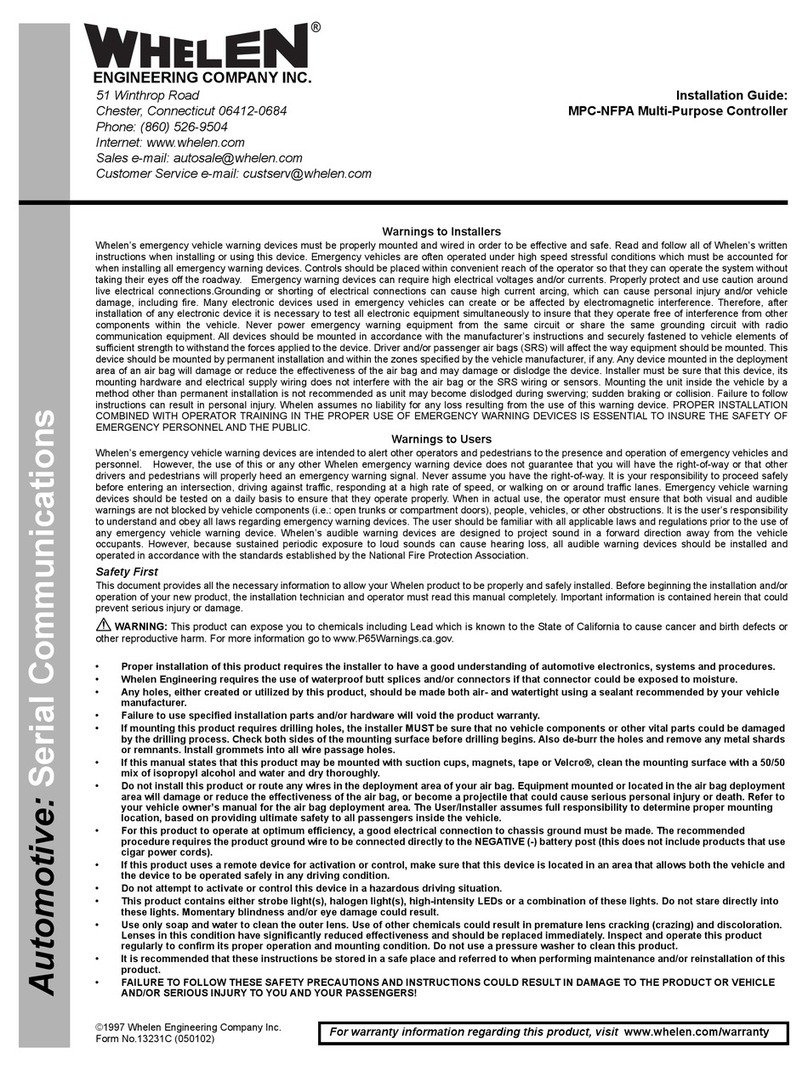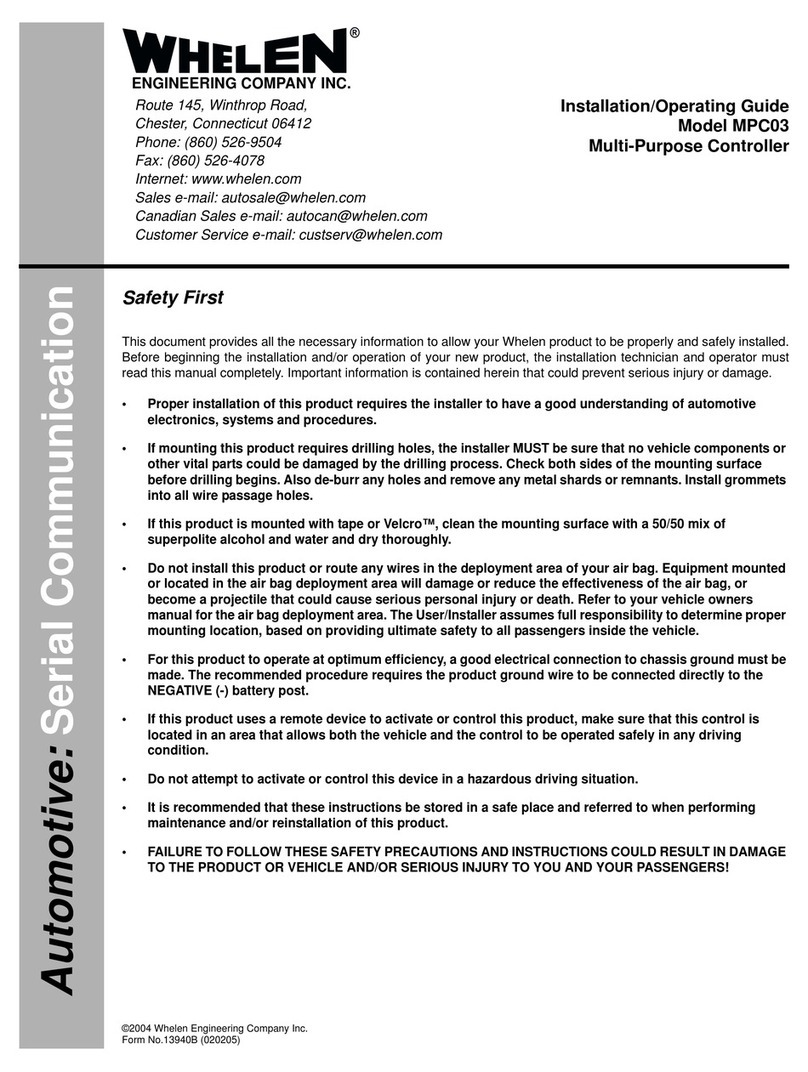
Page 2
Adjust RADIO or PA
volume, using a flat
blade screwdriver.
PA
VOL.
RADIO
VOL.
The 295SHA1 Siren/Howler Control Center
offers a unique collection of features
designed to allow the user to customize
operation to suit their individual needs.
Features include:
Siren:
• Non-destructive short circuit protection.
• Under/over voltage protection.
• LED fault indicators for speakers and input
voltage diagnostics.
• Title 13 compliant tone set up.
• 17 programmable tones.
• Horn-ring transfer relay built in.
• Two independent amplifiers drive one 100
watt speaker and one Howler speaker.
• 3 programmable low frequency tone styles.
• 8 Programmable Howler run times.
• Siren “in use” icon driver output.
• Siren disable (Park kill) control input.
• Includes Radio Repeat and PA.
Lighting control:
•11 Programmable lighting control Switches
(one 3 position slide switch and 8 momentary
switches).
• Three 20 Amp relay controlled outputs with
built in fuses.
• Eight 10 Amp relay controlled outputs with
built in fuses (two of them include a choice of
independent inputs or the standard power bus
switching).
• Two wire TrafficAdvisor™ control.
• Programming can not be activated by a user
in the cab.
• All switches can be programmed to activate/
deactivate any combination of relay outputs.
• All switches can be programmed to activate
any of the 8 momentary switches.
• Momentary switches can be programmed to
be activated as either a push-on / push-off,
momentary, flashing, timed output, or TA
control.
• All switches can be programmed to activate
the siren into HF mode.
• Copy one units configuration to another unit,
“CLONING”.
• Easy reset to factory default settings.
• Change the “Shutdown Delay” time.
• Program backlight intensity of control head.
Installation 295SHA1 Module:
1. Locate a suitable mounting location such as a dry, cool compartment
and position the unit where it will be mounted. Make
sure that the mounting area allows sufficient
ventilation. Using an awl or similar tool, scribe
the mounting surface where the
mounting holes are to be drilled.
2. Remove the unit and use a 9/64
drill bit to drill a hole in each of
the areas scribed in step 2.
3. Return the unit to its mounting
location and use the provided #10 x 3/4”
sheet metal screws and #10 internal tooth lock
washers to secure the unit to the mounting
surface. IMPORTANT: The case must be either
mounted on, or grounded to the vehicle chassis.
Control Head:
There are two control head mounting brackets to choose from. One allows
the control head to be mounted into your vehicle’s console (if so
equipped). The other allows the control head to be mounted directly onto
the dash or other surface through the use of a bail strap mounting bracket.
Regardless of the style selected, be sure to observe the air bag
warning on the cover of this manual.
Bail Strap Mount:
1. Position the bail strap in the selected
mounting location. Using
an awl or other suitable
tool, scribe the surface
where the mounting
holes are to be drilled.
2. Drill the mounting holes
in the areas scribed in
step 1. The size of the
drill bit should be determined by
the size of the mounting hardware
(#10 sheet metal screw) and thickness of
the mounting surface.
3. Using hardware provided (#10 x 3/
4” sheet metal screw and #10
internal tooth lock washer) secure
bail strap to mounting location.
NOTE: There are 3 sets of holes on
the bail strap for positioning the
control head at 3 different heights.
4. With the bail strap in place, insert the #10 x 3/8”
hex head bolt into the assembly hole from the inner
side of the bail strap as shown.
5. Place the #10 internal-tooth lock washer and the acorn nut on the
protruding bolt on the outer side of the bail strap. Loosely secure the
acorn nut to the hex head bolt.
Slide the control head onto the bolt heads. Once it is in position and the
control head has fully engaged the bolt heads, tighten the acorn nuts until
the unit is firmly secured.
A third pair of mounting holes are provided which allows the control head
to be located much closer to the bail strap. If this closer location is used,
the tips of the bail bracket may be broken off at
the notches.
Control Head Cable:
Route the control head cable from the amp/
relay module to the designated mounting
location. Plug the cable securely into the rear of
the control head. Be sure to route the cable
through either of the two recessed pathways (shown
here). This will prevent the cable from being disconnected or
pinched by the control head.
Havis Console Mount:
The Havis Console mounting kit includes all the necessary hardware
needed to secure the control head to the mounting bracket for installation
on a Havis Console. The control head mounts onto the console mount
bracket the same way the control head mounts onto the bail bracket as
outlined previously except for the addition of a flat washer that must be
inserted between the control head and the bracket. Please refer to the
manual included with your console for specific information on securing the
control head/mounting bracket assembly onto the console.
IMPORTANT! READ THESE WARNINGS BEFORE CONTINUING!
The Howler™ portion of this siren is a supplemental siren and was designed for use in high-risk areas such as an intersection. It is not intended to be,
nor should be operated as, a replacement or alternative to the vehicle’s primary siren.
The low-frequency tones of the Howler demonstrate significantly different audio characteristics as compared to those of a traditional higher-frequency
siren. While the low-frequency tones are better able to penetrate other vehicles, thus alerting drivers to the presence of the responding emergency
vehicle, these tones may also penetrate into the responding vehicle itself. This could potentially expose the operator to increased noise levels.
To help eliminate overexposure, the Howler siren has been designed with a built-in timing circuit. The Occupational Safety & Health Administration
(OSHA) (www.osha.gov) provides information necessary to determine safe exposure times in Noise and Hearing Conservation, Section 1910.95
(Occupational Noise Exposure). Until you have determined the safe exposure times for your specific application, this siren should be configured for the
minimum operating time and operators should be required to use an approved hearing protection device. FAILURE TO FOLLOW THIS
RECOMMENDATION COULD CAUSE HEARING LOSS!
